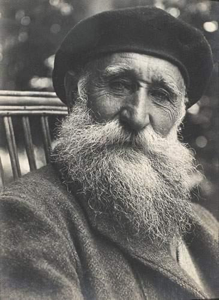Aristide Maillol
French, (1861–1944)
Aristide Maillol was born December 8, 1861, in Banyuls-sur-Mer, a small fishing village in the French Pyrenees. In 1881, he moved to Paris and began applying to the École des beaux-arts, to which he was finally accepted in 1885. He studied under the painters Alexandre Cabanel and Jean-Léon Gérôme, but became disillusioned with the strict academicism of their teaching. In May 1889 at an exhibition in the Café Volpini, Maillol encountered works by Paul Gauguin, which changed the direction of his art. Over the next few years, he produced stylized paintings of women, such as Mademoiselle Faraill au chapeau (Mademoiselle Faraill with a hat, 1890). Gauguin suggested he join the Nabis, a group of young artists influenced by Impressionism and the decorative elements of Art Nouveau and included Maurice Denis and Édouard Vuillard. Maillol became associated with the group and showed work with them in 1895 and 1896 at Louis le Barc de Boutteville’s Parisian gallery. Sharing the Nabis’ interest in the decorative arts, Maillol began working in tapestry; exhibited at the Salon des Beaux-Arts, Paris; and opened a workshop in his hometown in 1893. However, due to his declining eyesight, Maillol began producing small terracotta sculptures. By age 40, in 1901, he was almost exclusively a sculptor.
Maillol’s statuettes and his later, more monumental works focus on the female figure, thick-limbed, symmetrical, and highly archetypal. Working at a time marked by Auguste Rodin’s realist influence, Maillol instead emphasized the formal qualities of the body, rather than emotional or psychological meaning. In 1902 his first solo exhibition of tapestries and statuettes was held at Ambroise Vollard’s gallery in Paris. Over the next few years, he produced and reproduced several works and themes, including The Mediterranean (La Méditerranée, 1905), a half-seated, half-reclining figure based on his wife, which he exhibited at the 1905 Salon d’Automne. Maillol’s figures exude an overwhelmingly placid, stable, and self-contained air, even when the figure appears to be in motion, as in the walking woman of Ile-de-France (1925). For a public monument to the socialist Louis Blanqui, Maillol created Chained Action (Action enchaînée, 1905–08), an aggressively striding nude.
Maillol returned to two-dimensional work intermittently in his career: in 1912 he created a series of woodcuts for an edition of Virgil’s Eclogues (ca. 42–38 BCE) and in 1939, prints for poet Paul Verlaine’s Chansons pour elle (Songs for her, 1891). However, his primarily sculptural output of composed, harmonious nudes remained stylistically consistent. In 1934, he met 15-year-old Dina Vierny, who became his model and friend as well as accompanied him to Banyuls, where he worked in near solitude during World War II. After Maillol died in an automobile accident in Banyuls in 1944, Vierny established a foundation to administer his estate, which became two museums dedicated to his work: Musée Maillol, Paris and Banyuls-sur-Mer.
Source: Guggenheim Museum
French, (1861–1944)
Aristide Maillol was born December 8, 1861, in Banyuls-sur-Mer, a small fishing village in the French Pyrenees. In 1881, he moved to Paris and began applying to the École des beaux-arts, to which he was finally accepted in 1885. He studied under the painters Alexandre Cabanel and Jean-Léon Gérôme, but became disillusioned with the strict academicism of their teaching. In May 1889 at an exhibition in the Café Volpini, Maillol encountered works by Paul Gauguin, which changed the direction of his art. Over the next few years, he produced stylized paintings of women, such as Mademoiselle Faraill au chapeau (Mademoiselle Faraill with a hat, 1890). Gauguin suggested he join the Nabis, a group of young artists influenced by Impressionism and the decorative elements of Art Nouveau and included Maurice Denis and Édouard Vuillard. Maillol became associated with the group and showed work with them in 1895 and 1896 at Louis le Barc de Boutteville’s Parisian gallery. Sharing the Nabis’ interest in the decorative arts, Maillol began working in tapestry; exhibited at the Salon des Beaux-Arts, Paris; and opened a workshop in his hometown in 1893. However, due to his declining eyesight, Maillol began producing small terracotta sculptures. By age 40, in 1901, he was almost exclusively a sculptor.
Maillol’s statuettes and his later, more monumental works focus on the female figure, thick-limbed, symmetrical, and highly archetypal. Working at a time marked by Auguste Rodin’s realist influence, Maillol instead emphasized the formal qualities of the body, rather than emotional or psychological meaning. In 1902 his first solo exhibition of tapestries and statuettes was held at Ambroise Vollard’s gallery in Paris. Over the next few years, he produced and reproduced several works and themes, including The Mediterranean (La Méditerranée, 1905), a half-seated, half-reclining figure based on his wife, which he exhibited at the 1905 Salon d’Automne. Maillol’s figures exude an overwhelmingly placid, stable, and self-contained air, even when the figure appears to be in motion, as in the walking woman of Ile-de-France (1925). For a public monument to the socialist Louis Blanqui, Maillol created Chained Action (Action enchaînée, 1905–08), an aggressively striding nude.
Maillol returned to two-dimensional work intermittently in his career: in 1912 he created a series of woodcuts for an edition of Virgil’s Eclogues (ca. 42–38 BCE) and in 1939, prints for poet Paul Verlaine’s Chansons pour elle (Songs for her, 1891). However, his primarily sculptural output of composed, harmonious nudes remained stylistically consistent. In 1934, he met 15-year-old Dina Vierny, who became his model and friend as well as accompanied him to Banyuls, where he worked in near solitude during World War II. After Maillol died in an automobile accident in Banyuls in 1944, Vierny established a foundation to administer his estate, which became two museums dedicated to his work: Musée Maillol, Paris and Banyuls-sur-Mer.
Source: Guggenheim Museum
Artist Objects


